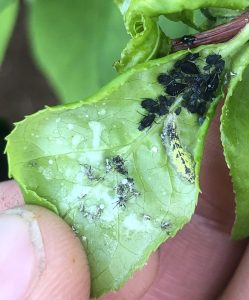UW-Madison/Extension Insect Diagnostic Lab Update May 16, 2024
Caseload at the UW Insect Diagnostic Lab (IDL) has started increasing as we progress into the growing season, and is expected to further increase over the next few weeks. A summary of recent cases at the IDL involving fruit crop insects can be found below:
Spongy moth: This has been the commonest fruit tree insect reported at the UW Insect Diagnostic Lab recently. Eggs have begun hatching in most of the state, although cooler spots in far northern Wisconsin (e.g., Bayfield Peninsula) may lag another week or so behind. Recent reports to the IDL have consisted of small, dark-coloured first and second instar caterpillars; most of these reports have come in from southern and central Wisconsin. Spongy moth caterpillars can feed on a wide range of fruit trees and landscape trees and shrubs. Most of the damage will be caused by later instar caterpillars which will be active in several weeks.
Eastern tent caterpillar: Eastern tent caterpillars are becoming active in the state with many recent reports in fruit trees from the southern third of the state. Look for conspicuous silken tents in fruit trees such as pome and stone fruits.

Aphids: Many aphid species can affect fruit crops. Similar to last spring, I’ve started seeing a lot of reports of aphid activity on fruit and landscape plants around the state. In some cases, beneficial predators, such as predatory hover fly larvae, are already making their presence known. Before considering any treatments for aphids, scout thoroughly for the presence of beneficial predators and parasites.
Strawberry rootworm (Paria fragariae): This is a type of small black and brownish Chrysomelid leaf beetle. I don’t receive many reports at the UW Insect Diagnostic Lab, but it can occasionally cause damage to fruit crops and ornamental landscape plants. I recently saw a case of damage to a young pear tree from southern Wisconsin. These can overwinter as adults and can be an occasional pest on rosaceous plants: strawberries, cane berries, apple, pear, roses, and others.
Periodical cicadas: The periodical cicada emergence has not yet begun but is expected to do so in the next week or two in areas such as Lake Geneva. In some spots, the emergence holes (prepared a few weeks prior to mass emergence) have been spotted. Emergence is linked to 8” soil temperatures exceeding 64˚F. At the time of writing, 8” soil temps in southern Wisconsin are currently in the high 50’s˚F. Cicada activity is expecting to peak in June and will subside as July approaches.
Visit the Wisconsin Periodical Cicada Website (cicadas.wisc.edu) for additional details and consider sharing your sightings and photos of periodical cicadas on that website.
Reminder about diagnostic support from the IDL: Growers and consultants in need of insect diagnostic services are always welcome to submit a sample to the UW Insect Diagnostic Lab. Lab services are provided free of charge. You can find additional information about the IDL here: insectlab.russell.wisc.edu
This article was posted in Insects and tagged aphids, eastern tent caterpillar, insect, Insect Diagnostic Lab, periodical cicadas, PJ Liesch, spongy moth, strawberry rootworm.
